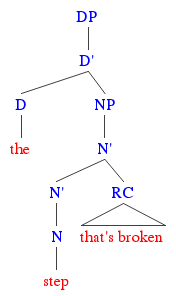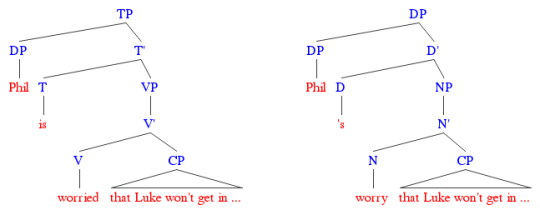#complement clauses
Inour episode on relative clauses, we focused on restrictive relative clauses, which we argued behave a lot like adjectives — specifically, intersective adjectives like “broken” and “curly.” In other words, if we think of both relative clauses and the nouns they combine with as sets, then the meanings we get out of connecting them together are whatever those sets share in common, or their intersection.
(1) “the broken step” ≈ “the step that’s broken”
And it makes sense to suppose that these kinds of relative clauses typically sit inside noun phrases, somewhere that’s neither too far up nor too far down the tree. After all, we can freely separate a relative clause from its host noun with a prepositional phrase, as in “the step in the middle of the staircase that’s broken,” suggesting the relative clause isn’t all that close to it to begin with. At the same time, the definite article seems to have a significant influence over everything that follows it, since out of all the steps and all the things that are broken, “the” picks out the one thing that’s both; this suggests that the relative clause is somewhere below the determiner.

But this isn’t the only kind of relative clause we find. If you want some more kinds of relative clauses, check below:
Consider the following sentence:
(2) Luke’s dad, who used to be a cheerleader, is also quite the prankster.
It doesn’t look like the relative clause “who used to be a cheerleader” is really restricting the meaning of “Luke’s dad.” In fact, if anything, it seems to be adding to it! In this case, we have what’s called a non-restrictive relative clause, which is often fenced off from the rest of the sentence with a slight pause (represented with commas).* And while restrictive relative clauses are generally thought of as combining meaningfully with the words around them, many linguists view non-restrictive relative clauses as being semantically separate from the rest of the sentence, as a kind of afterthought. The meaning of the sentence above, then, could be paraphrased like this:
(3) Luke’s dad is quite the prankster. Note that he used to be a cheerleader.
And non-restrictive relative clauses seem to be free of the influence of determiners. A sentence like “The President of France, who was recently elected to office, is relatively young” doesn’t seem to imply that there are a whole bunch of French Presidents, and that only one of them was recently elected; instead, the relative clause applies to everything that came before it — the whole of “the President of France,” including the definite article. So, we get a different picture of what these sorts of structures probably look like, with the non-restrictive relative clause attaching to some node sitting above the determiner phrase.

Finally, we see another brand of embedded clause that, on the surface, looks an awful lot like what we’ve seen already. Consider the following noun phrase:
(4) Phil’s worry that Luke won’t get into college
Notice, though, that unlike the relative clauses we’ve been seeing up until now, this one doesn’t have any gap in it; that is, it can stand on its own as a complete sentence.
(5) Luke won’t get into college.
These kinds of embedded clauses, which provide content to the nouns they modify, are known as complement clauses, because they look so much like the complements of verbs like “worry” and “claim” — found in full sentences like the one below.
(6) Phil’s worried that Luke won’t get into college.
And given their name, it seems reasonable to suppose they occupy a spot inside noun phrases that’s similar to the complements of these kinds of verbs, cozying up right next to the head of the phrase.

However, it turns out that this can’t quite be true. Not only are complement clauses able to follow restrictive relative clauses, it actually sounds kind of weird when they don’t! (And this is a pattern that holds across languages.)
(7a) I don’t believe the rumour that I heard this morning that he’ll move.
(7b) ??I don’t believe the rumour that he’ll move that I heard this morning.
Complement clauses even seem to work well after non-restrictive relative clauses.
(8) There’s a rumour, which I heard this morning, that he’ll be moving.
So complement clauses end up looking a lot like more some species of non-restrictive relative clauses than anything else (including real complements), meaning they probably connect up to a part of the tree that’s higher up than your average relative clause.
It really does take all kinds!
*Some insist on another difference between restrictive and non-restrictive relative clauses: that while either one may use relative pronouns like “who” or “where,” only restrictive relative clauses may use “that,” while only non-restrictive relative clauses may use “which.” But there are plenty of counter-examples to this supposed rule, as in Nietzsche’s famous quote “That which does not kill us makes us stronger.” And though non-restrictive relative clauses using “that” are very much an endangered species, they can still be spotted in the wild from time to time.
